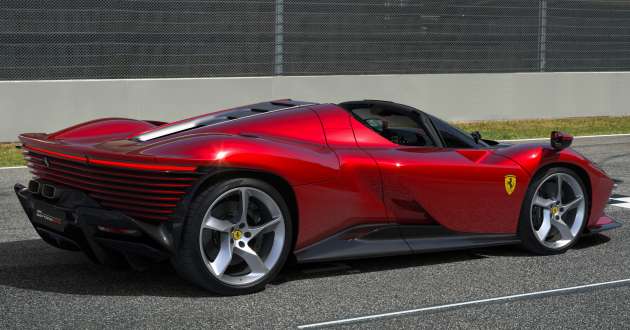It has to be said that Ferrari is putting out some stunning work these days. Back in 2018, the company introduced a pared-back design language with the retro Monza SP1 and SP2, then blew our socks off with the gorgeous Roma last year. Maranello is continuing its series of styling-led products with the new Daytona SP3, the third entry in the Icona range of hyper-expensive supercars after the Monza twins.
Now, at this juncture you may be wondering what on earth does a mid-engined sports car have to do with a front-engined GT from the late 1960s – you know, the Ferrari most people call the Daytona. Well, the 365 GTB/4 was never officially named that, so the SP3 is technically the first Prancing Horse model to actually be christened after the Florida race track.
The new model actually takes inspiration from Ferrari’s sports prototypes from the ’60s – specifically the 330 P3/4, 330 P4 and 412 P that finished first, second and third at the 1967 24 Hours of Daytona. The three cars were made to finish side-by-side in a big middle finger to Ford, which asked its trio of GT40s to do the same when it dominated the 24 Hours of Le Mans the year before.
The design of the Daytona SP3 harkens back to this era of Sixties excess, and this inspiration is visible in low nose and the voluptuous curves that drape over the four wheels. At the front, you’ll find a large central grille that is flanked by several strakes leading into the corner air inlets. The slim headlights, meanwhile, feature retractable “eyelids” that are meant to resemble pop-up headlights.
Further back, the dihedral doors incorporate large air scoops to feed the side-mounted radiators. This has necessitated the moving of the door mirrors to the front fenders, which not only clears the way for air to enter the intakes but also improves visibility and serves as another nod to the prototypes. The heavily-sculpted doors also manage the airflow from the front wheels and give the appearance of a pinched waist.
Also referencing the aforementioned racers is the wraparound windscreen, which leads into the domed cockpit and the removable hard top. The rear fenders bulge outwards for a very muscular look, before tapering into the most polarising part of the car – the slatted rear end. There are hints of the Testarossa here, and Ferrari has also ditched its quad taillight graphic for a single light bar running across the back.
In order to preserve the purity of the Daytona SP3, Ferrari relied on passive instead of active aerodynamics. There are dive planes hidden in corners of the front bumper, turbine-style alloy wheels, underfloor vortex generators, a large rear wing, a massive diffuser and, interestingly, floor “chimneys” that direct air upwards towards the rear fenders. All this allows the car to generate maximum downforce with minimal drag.



Under the skin, the Daytona SP3 is constructed entirely from carbon fibre, a material usually reserved for exalted limited-run hypercars like the LaFerrari. To reduce weight, the seats are integrated into the chassis itself (the steering wheel and pedals are adjustable instead), providing the lowest seating position for any road-going Ferrari.
The pews are covered in retro-style wraparound cushioning, which continues the minimalist theme set by the clean dashboard design. The sole piece of visible tech is the massive 16-inch curved instrument display first seen on the SF90 Stradale, positioned behind an oblong steering wheel with touch-sensitive controls.
As you can imagine, the sleek design hides an enormous amount of firepower. Behind the seats lies the 6.5 litre naturally-aspirated V12 from the 812 Competizione, which in its latest configuration spins to a barely-believable 9,500 rpm. As per the front-engined model, the stratospheric redline has been made possible thanks to titanium connecting rods, sliding finger followers for the valves and the use of diamond-like coating (DLC) to reduce friction.
However, the repositioning of the mill to the rear enables the intake and exhaust paths to be shorter and also improves fluid dynamic efficiency. The upshot is that the Daytona SP3 produces 10 PS and 5 Nm more than the Competizione, with outputs of 840 PS at 9,250 rpm and 697 Nm of torque at 7,250 rpm. Ferrari says this is the most powerful engine ever, enabling the car to get from zero to 100 km/h in 2.85 seconds, surpass 200 km/h in 7.4 seconds and hit a top speed north of 340 km/h.
All this fearsome power is sent to the rear wheels via a seven-speed dual-clutch transmission, now retuned to be “faster and more satisfying.” To keep the performance in check, the Daytona SP3 rides on bespoke Pirelli P Zero Corsa tyres and utilises the Competizione’s version 6.1 of Ferrari’s Side Slip Control (SSC) electronics – the first time fitted to a mid-engined model – with the Ferrari Dynamic Enhancer (FDE).
This being the apex of Ferrari’s lineup, don’t expect the Daytona SP3 to come cheap. According to Autocar, the company will build just 599 of these things, each priced at a cool €2 million (RM9.4 million). The company will give first dibs to owners of the Monza duo, with deliveries starting at the end of next year.





The post Ferrari Daytona SP3 revealed – new Icona model harks back to ’60s prototypes; 840 PS NA V12, RM9.4mil appeared first on Paul Tan's Automotive News.




0 Comments